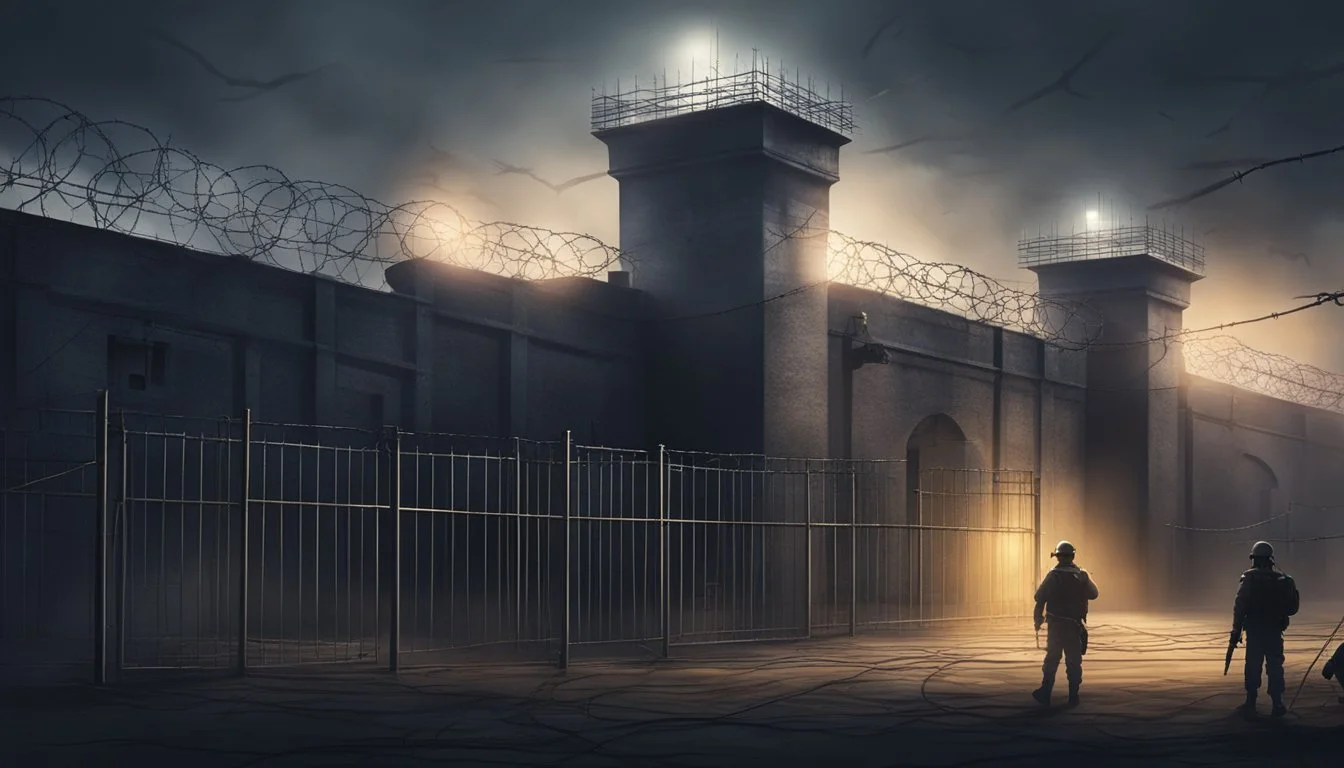10 Compelling Documentaries on Notorious Escape Artists and Prison Breaks
Unraveling Daring Getaways
Prison escapes have long captivated the public imagination, combining elements of suspense, ingenuity, and daring. Documentaries exploring these real-life breakouts offer viewers a glimpse into the minds of escape artists and the intricate plans they devised to gain their freedom.
These films delve into some of history's most infamous prison breaks, shedding light on the motives, methods, and aftermath of these audacious acts. From maximum-security facilities to remote island prisons, the documentaries showcase a range of escape attempts that have left an indelible mark on popular culture and criminal history. Viewers can expect to learn about the painstaking preparations, clever improvisations, and sheer determination that fueled these high-stakes bids for freedom.
1) Alcatraz: The Greatest Escape
Alcatraz Federal Penitentiary, known as "Hellcatraz," was America's most secure prison. Located on an island in San Francisco Bay, it housed infamous criminals like Al Capone and Machine Gun Kelly.
The June 1962 escape attempt remains the most audacious in U.S. history. Three inmates - Frank Morris and brothers John and Clarence Anglin - meticulously planned their breakout for months.
They created dummy heads to fool guards during night checks. Using stolen spoons and a homemade drill, they widened ventilation ducts to access the roof.
On the night of June 11, they slipped out of their cells and made their way to the shore. Using raincoats fashioned into a makeshift raft, they disappeared into the cold waters of the bay.
Their fate remains a mystery to this day. Despite an extensive manhunt, no bodies were ever found. The case remains open, with some believing the men may have survived.
This daring escape has captivated the public imagination for decades. It has been the subject of numerous documentaries, books, and even a Hollywood film.
2) Breakout Kings: The Real McCoy
"Breakout Kings: The Real McCoy" offers a gripping look at the true stories that inspired the popular TV series. This documentary explores the real-life U.S. Marshals who track down escaped convicts.
The film delves into the innovative tactics used by these law enforcement professionals. It showcases their collaboration with reformed criminals to catch fugitives on the run.
Viewers gain insight into the psychological cat-and-mouse game between pursuers and escapees. The documentary highlights several high-profile cases that mirror the dramatic scenarios portrayed in the TV show.
Expert interviews provide context on prison security measures and common escape methods. The film also examines the motivations driving inmates to attempt risky breakouts.
"Breakout Kings: The Real McCoy" balances thrilling narratives with factual analysis. It serves as both entertainment and an educational look at the complex world of fugitive recovery.
3) Escape from Pretoria
"Escape from Pretoria" is a gripping 2020 film based on the true story of Tim Jenkin and Stephen Lee's daring prison break. Set in South Africa during apartheid, the movie stars Daniel Radcliffe as Jenkin.
The film chronicles the ingenious escape of two political prisoners from Pretoria Central Prison in 1979. Jenkin and Lee, anti-apartheid activists, were imprisoned for distributing propaganda leaflets.
Using handmade wooden keys, the pair meticulously planned their escape over months. They studied guard routines and created precise replicas of the prison's locks.
The film depicts their tense journey through multiple locked doors, narrowly avoiding detection. Their escape route took them through ten locked gates before reaching freedom.
After their successful breakout, Jenkin and Lee fled to London. The movie is based on Jenkin's 2003 book "Inside Out: Escape from Pretoria Prison."
Filmed in Adelaide, Australia, "Escape from Pretoria" brings this extraordinary tale of courage and determination to life. It offers a glimpse into the risks political activists faced during apartheid.
4) The Great Escape
"The Great Escape" is a classic 1963 film based on the true story of a mass escape from a German prisoner of war camp during World War II. While not a documentary, it has inspired numerous documentaries and retellings of the real events.
The film dramatizes the elaborate plan devised by Allied prisoners to dig tunnels and coordinate a breakout of 250 men. It stars Steve McQueen, James Garner, and Richard Attenborough among an ensemble cast.
Several documentaries have been produced examining the actual escape attempt that took place in March 1944 at Stalag Luft III. These films often feature interviews with survivors and historical experts.
They detail the ingenuity of the prisoners in creating forged documents, civilian clothes, and tools for digging. The documentaries also explore the aftermath of the escape and the fate of the 76 men who initially got away.
The story continues to captivate audiences, with its themes of perseverance, teamwork, and the unbreakable spirit of prisoners of war. It remains a compelling subject for filmmakers seeking to portray one of World War II's most daring escape attempts.
5) Prison Break: The Legacy of Frank Morris
Frank Morris's daring 1962 escape from Alcatraz Prison captivated the nation and inspired numerous documentaries. His meticulous planning and execution of the breakout solidified his place in criminal lore.
Morris, along with brothers John and Clarence Anglin, spent months preparing for their escape. They created dummy heads to fool guards and fashioned a makeshift raft from raincoats.
On June 11, 1962, the trio slipped out of their cells through carefully widened vent holes. They climbed to the roof and descended to the shoreline, where they launched their improvised vessel into San Francisco Bay.
The fate of Morris and the Anglin brothers remains unknown to this day. Authorities never found conclusive evidence of their survival or demise, fueling decades of speculation.
Several documentaries have explored this infamous escape. They delve into the inmates' backgrounds, their intricate plans, and the ongoing mystery surrounding their ultimate fate.
These films often feature interviews with former guards, family members, and investigators. They examine physical evidence and assess various theories about what happened after the men left Alcatraz.
6) Shawshank Redemption: Fact or Fiction?
The Shawshank Redemption, while a beloved film, is not a documentary. It is based on a fictional novella by Stephen King titled "Rita Hayworth and Shawshank Redemption."
The story of Andy Dufresne's escape from Shawshank prison is entirely fictional. However, some elements of the film draw inspiration from real-life events and social issues of the time period it portrays.
For instance, the racial tensions depicted in the movie reflect the broader societal struggles of the era. The discrimination faced by prisoners in the film mirrors real-world challenges of the time.
While the specific events and characters are not real, the film's portrayal of prison life and the human spirit resonates with audiences. It captures universal themes of hope, friendship, and perseverance in the face of adversity.
The Shawshank Redemption's power lies in its ability to blend fictional storytelling with relatable human experiences. This combination creates a compelling narrative that feels authentic despite its fictional nature.
7) Houdini: The Real Story
Harry Houdini was one of the most famous escape artists and magicians in history. Born in 1874 as Erik Weisz, he immigrated to the United States from Hungary as a child.
Houdini gained fame for his sensational escape acts, which often involved handcuffs, straitjackets, and water tanks. He could free himself from seemingly impossible situations, thrilling audiences worldwide.
His most famous stunts included the Chinese Water Torture Cell and the Milk Can Escape. Houdini also exposed fraudulent mediums and spiritualists, using his knowledge of magic to debunk their claims.
Despite his reputation for death-defying feats, Houdini died unexpectedly at age 52. He passed away on Halloween in 1926 due to peritonitis caused by a ruptured appendix.
Houdini's life and career have been the subject of numerous books, films, and documentaries. His legacy continues to inspire magicians and escape artists to this day.
8) Escape from Dannemora
The 2018 Showtime limited series "Escape at Dannemora" chronicles one of the most notorious prison breaks of the 21st century. The show depicts the true events that unfolded at Clinton Correctional Facility in Dannemora, New York, in June 2015.
Two inmates serving life sentences for murder, Richard Matt and David Sweat, orchestrated an elaborate plan to break out of the maximum-security prison. Their escape was aided by Joyce Mitchell, a prison employee who became romantically involved with the pair.
The series, starring Benicio del Toro, Paul Dano, and Patricia Arquette, offers a gripping portrayal of the meticulous planning and execution of the escape. It explores the complex relationships between the inmates and Mitchell, as well as the subsequent manhunt.
The real-life escape captured national attention, drawing comparisons to Hollywood prison break films. The series provides insight into the vulnerabilities of the correctional system and the human factors that can compromise security.
"Escape at Dannemora" garnered critical acclaim for its performances and direction. It offers viewers a detailed look at the events leading up to, during, and after the daring prison break that shocked the nation.
9) The Texas Seven: True Crime
The Texas Seven gained notoriety for their daring prison break from the John B. Connally Unit in Kennedy, Texas on December 13, 2000. This group of seven inmates executed one of the most audacious escapes in U.S. history.
Their story captivated the nation and became the subject of multiple true crime documentaries. These films delve into the meticulous planning and execution of their escape, as well as the subsequent manhunt.
The escapees managed to evade authorities for over a month, committing various crimes along the way. Their time on the run came to an end between January 22-24, 2001, when six of the seven were apprehended.
The capture of the Texas Seven was largely attributed to their feature on the television show America's Most Wanted. This highlights the significant role media can play in solving high-profile cases.
The seventh member of the group chose to end his life rather than face arrest, adding a tragic element to an already gripping story. Documentaries exploring this case offer viewers a detailed look at one of the most infamous prison breaks in recent memory.
10) The Real Papillon
Henri Charrière, known as Papillon, gained fame for his alleged escapes from French Guiana's notorious penal colonies. Born in 1906, Charrière was convicted of murder and sentenced to life imprisonment in 1931.
His autobiography, "Papillon," published in 1969, recounts daring escape attempts and brutal conditions in the South American prisons. The book became an international bestseller, selling over 700,000 copies in its first 10 weeks.
Charrière claimed his story was "75 percent true," though French authorities have questioned certain elements of his narrative. The book's success led to a 1973 film adaptation starring Steve McQueen.
Saint Laurent de Maroni, one of the penal colonies Charrière described, became infamous for its harsh conditions. His vivid accounts of life there and on Devil's Island captured the public's imagination.
While the full extent of Charrière's exploits remains debated, his story continues to fascinate readers and viewers. It highlights the brutal realities of the French penal system and the human spirit's resilience in the face of adversity.
Historical Context of Prison Breaks
Prison breaks have captured public imagination for centuries, evolving alongside advancements in security and incarceration practices. These daring escapes reflect both human ingenuity and the ongoing cat-and-mouse game between prisoners and authorities.
Evolution of Escape Techniques
Early prison breaks often relied on brute force or simple deception. Inmates might overpower guards or disguise themselves to walk out undetected. As prisons became more sophisticated, so did escape methods.
Tunneling emerged as a popular technique in the 19th century. Prisoners would painstakingly dig passages under prison walls, sometimes over months or years. The famous 1962 Alcatraz escape utilized this method, with inmates using spoons and other makeshift tools to chip away at cell walls.
Technology played an increasing role in 20th-century escapes. Prisoners began using electronic devices to bypass security systems or communicate with outside accomplices. Some even attempted helicopter escapes, like the 1971 break from Santa Martha Acatitla prison in Mexico.
Famous 20th Century Breakouts
The 20th century saw several high-profile prison breaks that captured global attention. In 1944, 76 Allied airmen escaped from Stalag Luft III, a German POW camp, in an event later known as "The Great Escape."
Alcatraz, once considered escape-proof, experienced its most notorious breakout in 1962. Frank Morris and the Anglin brothers disappeared into San Francisco Bay, their fate still unknown.
The 1978 escape of James Earl Ray, assassin of Martin Luther King Jr., from Brushy Mountain State Penitentiary shocked the nation. Though recaptured, his brief freedom highlighted ongoing security concerns in maximum-security facilities.
These incidents led to significant reforms in prison security measures worldwide, shaping modern incarceration practices.
Psychology of Escape Artists
The mindset and characteristics of prison escapees reveal fascinating insights into human psychology and determination. These individuals often possess unique traits and motivations that drive them to attempt daring breakouts.
Motivations for Prison Breaks
Freedom is the primary motivator for most escape attempts. Many prisoners feel unjustly incarcerated or face harsh conditions, fueling their desire to break free. Some seek to reunite with loved ones or fear for their safety within prison walls.
Financial incentives can also play a role. Certain escapees aim to access hidden assets or resume criminal activities. Others are driven by the thrill of the challenge, viewing escape as the ultimate test of their abilities.
Personal beliefs or ideological reasons sometimes factor in, especially for political prisoners. These individuals may see escape as a continuation of their cause or a way to avoid persecution.
Profiles of Notorious Escapees
Escape artists often share common personality traits. They tend to be highly intelligent, creative problem-solvers with exceptional planning skills. Many display patience and persistence, meticulously preparing for months or even years.
Risk-taking behavior and a high tolerance for stress are frequently observed. These individuals can remain calm under pressure and adapt quickly to changing circumstances.
Some notorious escapees, like Pascal Payet, demonstrate audacity and flair. Payet orchestrated multiple helicopter escapes, showcasing both ingenuity and daring.
Others, such as André Devigny, exhibit remarkable resourcefulness. Devigny's escape from a Nazi prison during World War II, as depicted in "A Man Escaped," highlights his meticulous attention to detail and unwavering determination.





